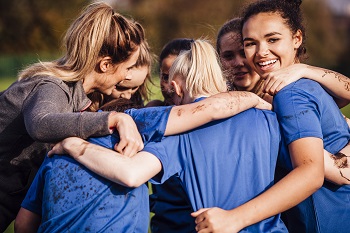Policies
School sport and activity action plan, UK Government, Department for Education, Department for Digital, Culture, Media and Sport, and Department of Health and Social Care, (July 2019). A cross-government action plan to provide pupils with greater opportunity to access 60 minutes of sport and physical activity every day. The action plan: outlines a range of new measures to strengthen the role of sport within a young person’s daily routine; explains how teachers and parents can play their part; and, promotes a joined-up approach to physical activity and mental wellbeing.
Active for College, Work and Life: a strategy for physical activity and sport for disabled college students, Association of Colleges Sport, (2018). This AoC Sport-led strategy is the first of its kind in the FE sector and builds on the findings published in AoC Sport’s review ‘The current landscape of physical activity and sport for disabled students’. It aims to create a step change in physical activity and sport for students with disabilities and reveals how AoC Sport will support colleges and partner organisations to achieve the vision of every disabled college student active for college, work and life.
- The current landscape of physical activity and sport for disabled students: a review into the opportunities, barriers and attitudes to physical activity and sport for disabled students in further education (FE) colleges, Association of Colleges Sport, (2018). To gain an insight into the current landscape of physical activity and sport for disabled students in colleges. The review consisted of: studying relevant secondary data and research; engaging with 107 colleges via visits, meetings, events, calls and emails; interviewing and feedback from 60 disabled students; and consulting with 12 partner organisations.
- A gap exists between the number of disabled students (one in six) and the number of disabled students that are participating (1 in 13), competing (1 in 13 sports) and studying (1 in 16) physical activity and sport.
- Barriers to physical activity and sport for disabled students: Logistical (limited workforce; limited time; limited funding; travel); Physical (lack of facilities and equipment); Psychological (sport isn't a priority, staff not qualified to deliver disability sport).
- Disabled students' motivations for being active: fun, fitness, improve health, lose weight, stay healthy.
Organisations
Association of Colleges Sport (AoC Sport) is the membership organisation for colleges, leading the development of sport and physical activity in 16+ education. We believe that sport and physical activity are essential components of college life, giving students significant advantages in education, employment and health. Our vision is for every college student to participate regularly in sport or physical activity. Our purpose is to promote, support and deliver college sport and physical activity.
The Youth Sport Trust (YST) is an independent charity devoted to changing young people’s lives through sport. The YST is passionate about helping all young people to achieve their full potential by delivering high quality physical education (PE) and sport. The YST is a strong advocate for school PE and sport and has driven many improvements and continuously looks at new ways to inspire young people to participate, compete, volunteer and officiate. The YST believes that every young person’s life can be transformed by PE and sport, whatever their age or ability. The YST works in partnership with schools, sponsors, government, sporting organisations and young people to achieve its objectives.
Reports
What works in schools and colleges to increase physical activity, Public Health England, (2020). A report that summarises evidence of what works in schools and colleges to promote levels of activity among children and young people. This resource brings together key guidance and policy documents on increasing physical activity alongside local examples, which has been produced to support schools and colleges, develop and implement effective evidence-based approaches utilising 8 key principles.
British Active Student Survey, UK Active, (2019). The British Active Students Survey, now in its fourth year, continues to provide us with even greater evidence of the valuable role physical activity can play in students’ lives. For the first time this year, the survey combines Further and Higher Education in a collaboration between AoC Sport, BUCS, and ukactive, with support from Matrix Fitness and Sport England. The 2019 report calls for college and university students to be given more support to increase their physical activity levels, and that this is a responsibility that is shared between the educational institutions, policy makers and welfare organisations. Students indicated that the biggest motivator to take part in physical activity was to look after their health. The largest barrier in participation was being too busy with studies. However, students who participated in physical activity did not say that it interfered with their studies. Other barriers to participation included clubs being too expensive to join or that students perceived activities as being unwelcoming. The data collected and presented within this report was collected before the COVID-19 (coronavirus) pandemic and restrictions subsequently put in place. The findings have been presented as such and are not reflective of any changes that may have occurred due to the pandemic and restrictions.
Improving mental wellbeing in colleges through physical activity, Association of Colleges Sport, (2018). This project was focused on using physical activity as an intervention for students with mental health issues or low levels of wellbeing. Fifteen colleges participated in the intervention, identifying students that needed support and were open to trying physical activity to improve their mental wellbeing. Individual activities seem to have been most popular, particularly the gym and boxing. Some staff members attributed this trend to a lack of confidence stopping the students from engaging in group activities. Colleges which were able to provide private space or facility access for these activities referenced how important this was to many of their students. The average wellbeing change of respondents was: +3.13% for positive activity change participants; +0.79% for no activity change participants; -0.25% for negative activity change participants.
Active Beyond Education? A report exploring young disabled people’s experiences of sport and physical activity, during the transition from education to adulthood, Activity Alliance, (2015). Commissioned by six of the UK's National Disability Sports Organisations, in partnership with Activity Alliance and supported by Sport England. The research aims were to: Better understand reasons for the decline on disabled people's participation in sport and physical activity, during the transition from education to adulthood; Recommend how to promote and maintain engagement in sport and physical activity amongst young disabled people. The findings highlighted a range of reasons why disabled people do and do not engage in sport and physical activity as they move on from education. These cover internal factors – having the motivation as well as the physical and psychological capability to take part. As well as external factors – having available opportunities.
The PE and sport premium for primary schools: Good practice to maximise effective use of funding, Ofsted, publication reference number 140164 (2014). Ofsted is the Office for Standards in Education, Children’s Services and Skills in the United Kingdom. Ofsted is an independent body that provides inspection and regulatory services and reports directly to Parliament. The government is providing funding to primary schools and academies that is specifically targeted at improving the provision of physical education (PE) and sport. A survey conducted during April to July 2014 identified good practice in 22 schools previously identified as performing well in PE. This report shares the results of that survey. In most of the schools surveyed, additional funding was being used to:
- deploy new sports coaches and other qualified personnel;
- join existing sports partnerships by pooling resources and organising inter-school sports competitions;
- improve teacher’s subject knowledge, techniques and skills;
- work in partnership with secondary schools to facilitate specialist teachers and coaches in extra-curricular sport;
- engage with parents and community sports clubs to increase pupils’ regular participation in sport and physical activity outside of school hours, and;
- help selected pupils, including persons with disability, who have special needs to overcome barriers and benefit from PE and sport.
Resources
Changing the Game, for Girls: A toolkit to help teachers get more girls involved in PE and school sport, Women’s Sport and Fitness Foundation, UK (2016). This resource is designed to help schools and physical education (PE) teachers get more girls involved in PE and school sport by understanding the reasons why so few girls participate. Underpinning research at Loughborough University examined the reasons for the gender gap in PE and school sport participation. Population statistics also show that young girls in the UK are less likely to meet the recommended daily physical activity target than boys and a high proportion of girls are overweight or obese. The research can help us understand what would help girls become more active, so that schools can develop policies and strategies to encourage greater participation among girls. Overall, this research found that families are the most powerful influence on a child’s activity levels, and schools are seen as the most important site for change. Because school attendance is compulsory, schools have a unique opportunity to deliver programs (e.g. PE and school sport) and create a culture in which physical activity is valued. A whole-school approach is recommended, involving students, parents and teachers.












